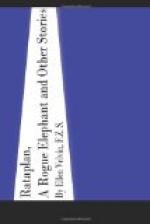As soon as the lion turned his back, poor Gean sank down utterly exhausted, her small head waving wearily to and fro, her long, black tongue hanging out of her mouth, and her breath coming in short, painful gasps. Groar comforted her as well as he could, caressing her tenderly, and every now and then drawing himself up to his full height on the lookout for danger. He never left her until she was able to move slowly back to the low woods, and then only to gather for her some tender shoots of camel-thorn and mimosa, and any young, tender leaves he could find.
Gean took them all very gently, and seemed humbled and grateful, and when, a little later on, he suggested that she should let him always take care of her, she thought it over and finally concluded it would be a very nice arrangement. And so Groar took her home to his herd and introduced her to the leader—an old giraffe with a dark chestnut hide and a longer neck than any of the others—as his wife.
And Gean was very happy, for Groar was a good and kind husband, and very devoted to her, and she no longer had to be always looking out for danger, for Groar was always watching, and guarded her with the greatest care. He took her for long walks through the woods, where they found nice, fresh food, and saw that she had her share of it, but they picked and ate only a few leaves or blades of grass at a time, for it is a provision of Nature that giraffes shall feed in this way, as their digestion is extremely delicate.
In times of danger they would get close to a tree, lean their bodies against it, and then, putting their heads and necks under the branches, would be so completely hidden that sometimes the natives would mistake the giraffes for trees, and the trees for giraffes. Gean and Groar were more easily hidden than some of their cousins who lived in Northern Africa, for, being South Africans themselves, they were of a much darker color, and therefore not so noticeable.
[Illustration: “GROAR JOINED IN WITH MIGHT AND MAIN.”]
It was in this way that they saved themselves one day, when, followed by hunters. These hunters were mounted on good, fleet horses, and had traced the pair of giraffes by their spoor, or footmarks. These footmarks were ten or eleven inches in length, pointed at the toe, and rounded at the heel, so that it was quite easy to find which way the giraffes had gone.
Accordingly, the hunters followed the spoor, which went across miles of rough, uneven ground—for giraffes know perfectly well that they always have the advantage on rough ground, being able to leap over obstacles without diminishing their speed—and finally led them to a wood.
Here the hunters paused, and, finding it impossible to ride through the thick growth, tethered their horses and left them in charge of some natives, while they, creeping cautiously forward, with guns in hand, tried to find out in which direction the animals had gone.




